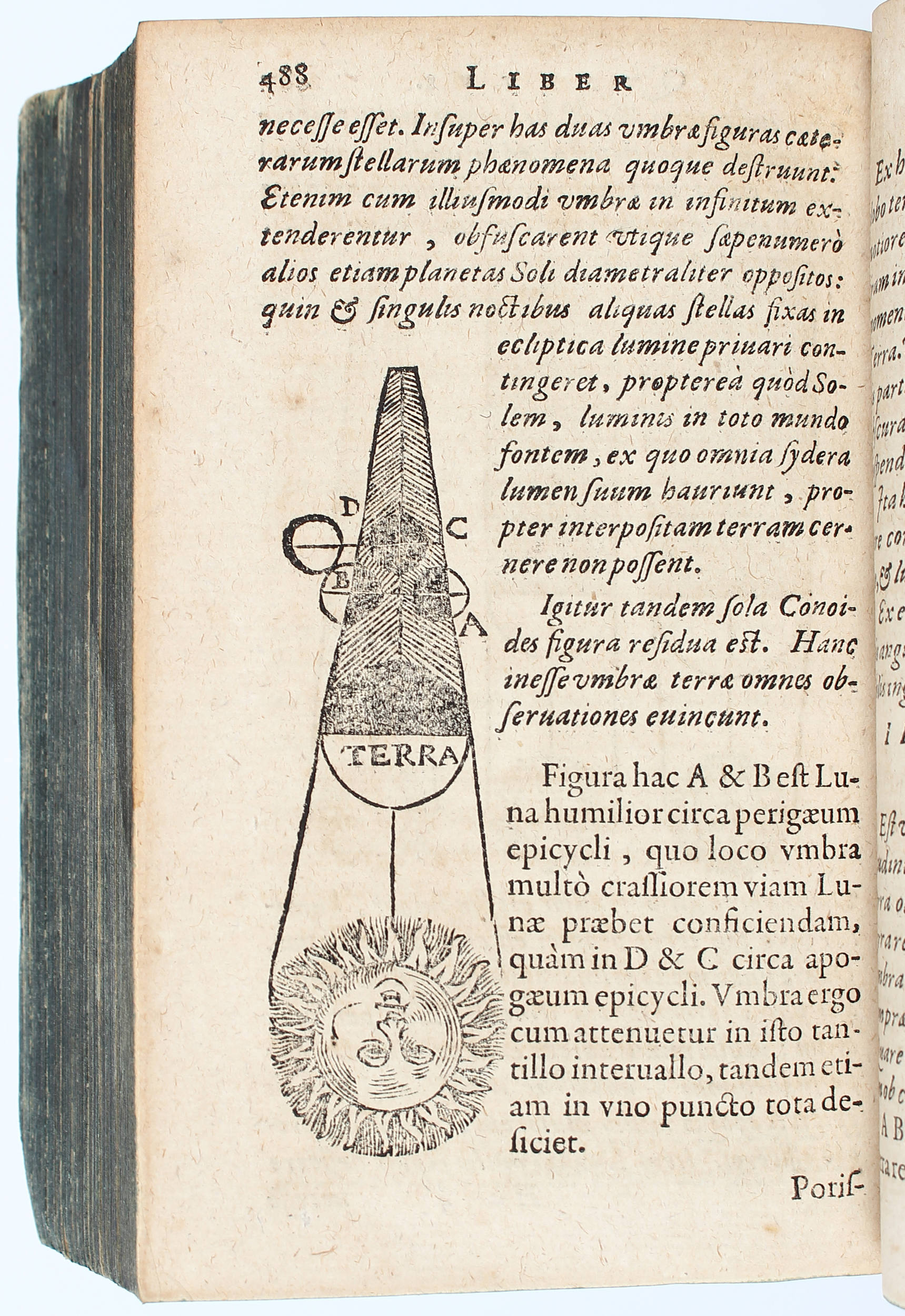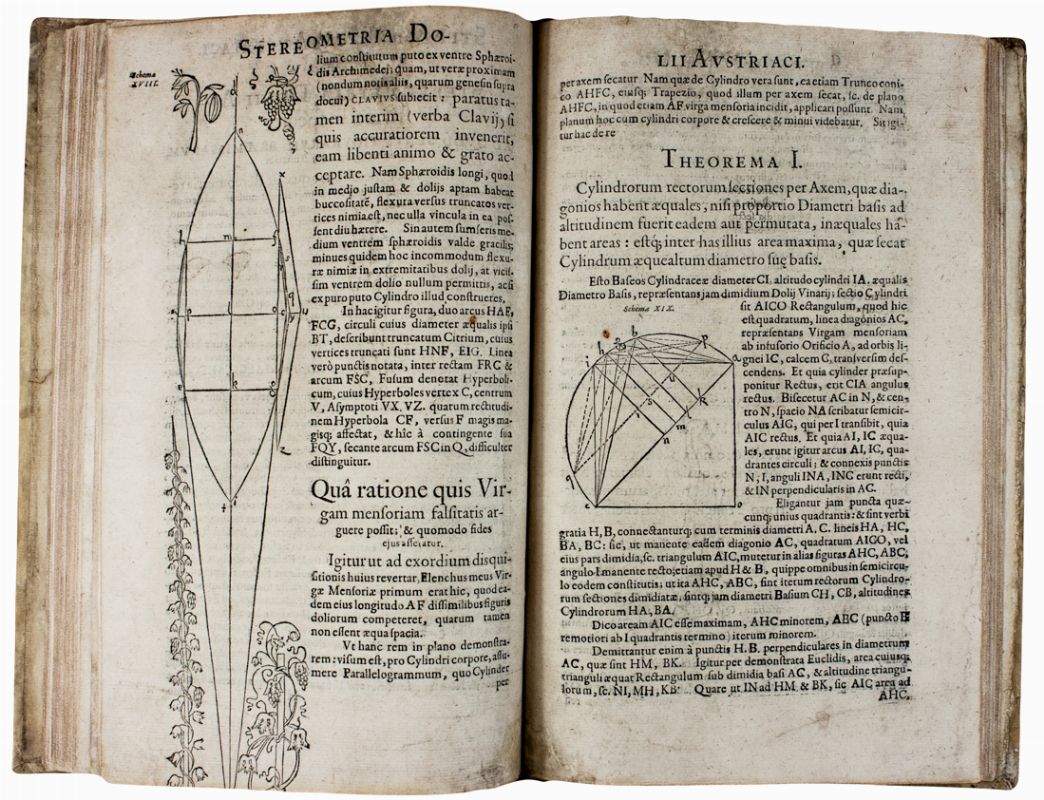KEPLER, Johannes (1571-1630). Epitome astronomiae copernicanae . Linz: Johann Planck [vol. I], Linz: Johann Planck for Gottfried Tambach, and Frankfurt: Gottfried Tambach [vol. III], 1618-'1622' [?1620]-1621.
KEPLER, Johannes (1571-1630). Epitome astronomiae copernicanae . Linz: Johann Planck [vol. I], Linz: Johann Planck for Gottfried Tambach, and Frankfurt: Gottfried Tambach [vol. III], 1618-'1622' [?1620]-1621. 3 volumes in 2, 8° (155 x 91mm). Book 2 part-title with woodcut vignette, woodcut illustrations, woodcut ornaments, one folding letterpress table, other letterpress tables in text. Vol. I with final blank C6. (Variable light spotting and browning, light staining in early and final quires, occasional small flaws affecting text, 2 ll. trimmed touching tables, vol. I and II titles supplied from another copy and with traces of removed stamps, the first with small repair.) 19th-century half roan, spine gilt in compartments, lettered in one, later paper spine labels (a little rubbed, spines faded, hinges cracking). Provenance : occasional marginal markings -- Groeger (19th-century inscriptions on front endpaper) -- small inscriptions on front endpapers with labels pasted over. FIRST EDITION OF 'KEPLER'S LONGEST AND MOST INFLUENTIAL WORK' ( DSB VII, p. 302). Following the publication of his Astronomia nova in 1609, Kepler was asked to write a more popular exposition of Copernican astronomy; however, 'despite its title, Kepler's Epitome was more an introduction to Keplerian than to Copernican astronomy' ( loc. cit. ). The work was written during a period of upheaval (Kepler's mother had been charged with witchcraft and threatened with torture, the first volume's advocacy of the Copernican system soon earned it a place on the Index librorum prohibitorum ), and the seven books were issued in three inexpensive octavo volumes, titled 'Doctrina spherica', 'Physica coelestis', and 'Doctrina theorica', over a period of some three years. Intended to be an easily-comprehensible textbook of the new heliocentric astronomy, the Epitome was laid out in a catechetical form which imparted the information through questions and answers, employing a technique typical of many astronomical textbooks of the period. Beyond its stated educational purpose, it expanded on Copernican theory -- with regard to the motions of the earth, Kepler extended the work of Copernicus and correctly formulated the principles which Galileo would in turn discuss in more detail in his Dialogo of 1632. It also served to enlarge upon Kepler's own work: 'the most remarkable section ... was book IV, on theoretical astronomy, subtitled, "Celestial Physics" ... to a great extent it epitomized both the Harmonice mundi [of 1619] and the new lunar theory that Kepler completed in April 1620 ... The harmonic law, which Kepler had discovered in 1619 and announced virtually without comment in the Harmonice mundi , received an extensive theoretical justification in the Epitome ' ( op. cit. , p. 303). Carli and Favaro 76 and 92 (vols I and II); Cinti 60, 72, and 67; Houzeau and Lancaster 11831; Waller 12066 (vol. I only). (2)
KEPLER, Johannes (1571-1630). Epitome astronomiae copernicanae . Linz: Johann Planck [vol. I], Linz: Johann Planck for Gottfried Tambach, and Frankfurt: Gottfried Tambach [vol. III], 1618-'1622' [?1620]-1621.
KEPLER, Johannes (1571-1630). Epitome astronomiae copernicanae . Linz: Johann Planck [vol. I], Linz: Johann Planck for Gottfried Tambach, and Frankfurt: Gottfried Tambach [vol. III], 1618-'1622' [?1620]-1621. 3 volumes in 2, 8° (155 x 91mm). Book 2 part-title with woodcut vignette, woodcut illustrations, woodcut ornaments, one folding letterpress table, other letterpress tables in text. Vol. I with final blank C6. (Variable light spotting and browning, light staining in early and final quires, occasional small flaws affecting text, 2 ll. trimmed touching tables, vol. I and II titles supplied from another copy and with traces of removed stamps, the first with small repair.) 19th-century half roan, spine gilt in compartments, lettered in one, later paper spine labels (a little rubbed, spines faded, hinges cracking). Provenance : occasional marginal markings -- Groeger (19th-century inscriptions on front endpaper) -- small inscriptions on front endpapers with labels pasted over. FIRST EDITION OF 'KEPLER'S LONGEST AND MOST INFLUENTIAL WORK' ( DSB VII, p. 302). Following the publication of his Astronomia nova in 1609, Kepler was asked to write a more popular exposition of Copernican astronomy; however, 'despite its title, Kepler's Epitome was more an introduction to Keplerian than to Copernican astronomy' ( loc. cit. ). The work was written during a period of upheaval (Kepler's mother had been charged with witchcraft and threatened with torture, the first volume's advocacy of the Copernican system soon earned it a place on the Index librorum prohibitorum ), and the seven books were issued in three inexpensive octavo volumes, titled 'Doctrina spherica', 'Physica coelestis', and 'Doctrina theorica', over a period of some three years. Intended to be an easily-comprehensible textbook of the new heliocentric astronomy, the Epitome was laid out in a catechetical form which imparted the information through questions and answers, employing a technique typical of many astronomical textbooks of the period. Beyond its stated educational purpose, it expanded on Copernican theory -- with regard to the motions of the earth, Kepler extended the work of Copernicus and correctly formulated the principles which Galileo would in turn discuss in more detail in his Dialogo of 1632. It also served to enlarge upon Kepler's own work: 'the most remarkable section ... was book IV, on theoretical astronomy, subtitled, "Celestial Physics" ... to a great extent it epitomized both the Harmonice mundi [of 1619] and the new lunar theory that Kepler completed in April 1620 ... The harmonic law, which Kepler had discovered in 1619 and announced virtually without comment in the Harmonice mundi , received an extensive theoretical justification in the Epitome ' ( op. cit. , p. 303). Carli and Favaro 76 and 92 (vols I and II); Cinti 60, 72, and 67; Houzeau and Lancaster 11831; Waller 12066 (vol. I only). (2)






.jpg)

.jpg)





Testen Sie LotSearch und seine Premium-Features 7 Tage - ohne Kosten!
Lassen Sie sich automatisch über neue Objekte in kommenden Auktionen benachrichtigen.
Suchauftrag anlegen